Subwoofers for home: the best models and secrets of choice
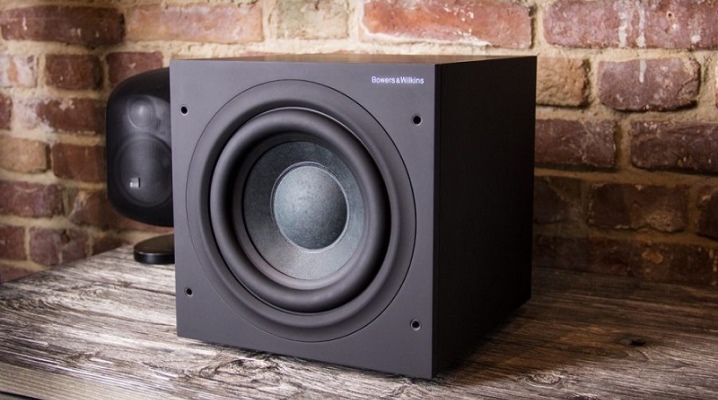
Subwoofers for home - active and passive for cinema, sound systems, are customary to purchase if you want to get a really deep and beautiful sound. This component is necessary for reproducing the lowest frequencies; without it, it is impossible to achieve that volumetric effect when working with acoustics, which is so appreciated by real music lovers and fans of cinema.
What you need to know before choosing the best model for home, what setting the device will need to work correctly, what are the secrets of the choice - it is worth understanding all this in more detail.
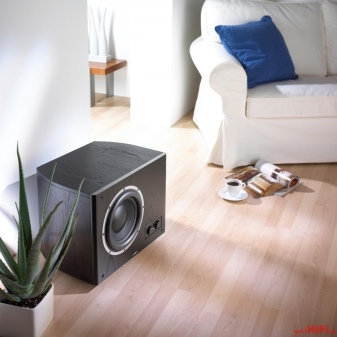
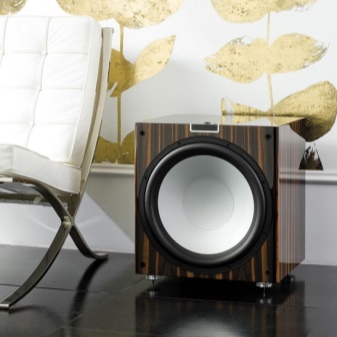
Main characteristics
A subwoofer is a device that operates at the lowest frequencies. With its help, you can achieve the "effect of presence", full immersion in the atmosphere of the events taking place on the screen. For a home theater, this component is especially important, because without it the sound will be "flat". A music center or acoustics with a subwoofer also begins to sound completely differently, showing all the depth and power of the bass lines. To connect it, you do not need a wire - modern device models quite successfully do without it, forming a connection via Bluetooth.
The subwoofer for home is a compact speaker system capable of reproducing sounds in the frequency range from 15 to 180 Hz, but the human ear perceives them before reaching 20 Hz, so you should not look for the lowest values.
According to the type of head design, all models are divided into strip, closed and bass reflex.
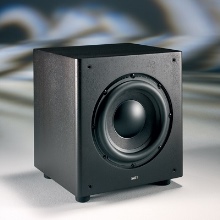
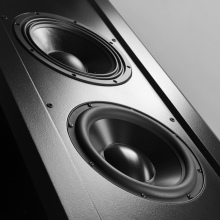

The main characteristics of the product include power. It is determined based on similar indicators of the other components of the system. On average, the proportion should be as follows: for 1 W of the front speaker, 1.5 W of the subwoofer. The correct ratio helps to obtain good dynamic performance.
Among the characteristics of passive subwoofers, you can find the recommended power. Active models will simply have RMS / DIN designation instead of this parameter. The crossover frequency is equally important - it determines from what moment the sound will be reproduced by the subwoofer. For example, at 120 Hz, the subwoofer will take over all the lower signals. Sensitivity - this characteristic determines the sound volume. The higher it is, the better the amplifier efficiency factor will be. At low sensitivities, even powerful speakers do not sound too loud. Audio systems that already have a subwoofer are designated as 2.1, 5.1, 7.1, where 1 after the dot and indicates the presence of a device for reproducing low frequencies.
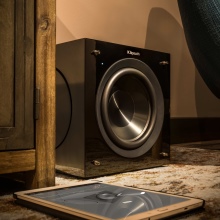


Species overview
All subwoofers for home theater or music acoustics have different types of cabinet designs, with or without a built-in amplifier. The sound quality largely depends on the acoustic design. All subwoofers can be divided into several types according to their design.
- Closed. The simplest in execution, without sound leakage from the side of the radiating surface. Subwoofers of this type have the ability to reproduce rich, deep bass, but the sound pressure on the head cone also increases due to their design features. Manufacturers have to find a compromise - make the case more bulky or lose the quality and volume of sound.
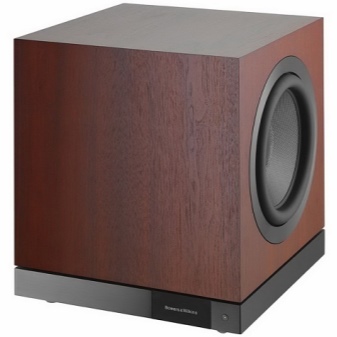
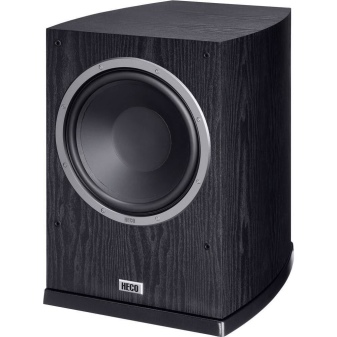
- Bass reflex. These subwoofers have a bass reflex - a round hole located on the side, rear or front panel. This design increases the range of travel of the cone, it becomes possible to reproduce even lower bass. And also its distinctive feature is increased sensitivity to sound distortion, the device requires fine and precise adjustment.
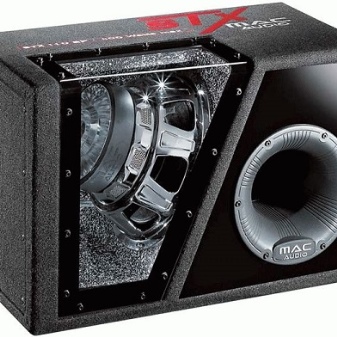
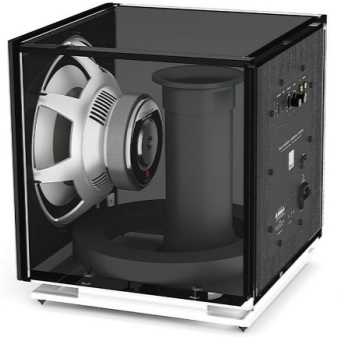
- Striped. These options are considered to be a kind of filter with similar functionality. The case of such a subwoofer is divided into 2 parts - completely closed and bass reflex, with a hole. The system gets a smaller range, but the volume rises significantly. Bandpass filter subwoofers have the ability to fine tune and combine the advantages of other types of construction.
Bass-reflex models are considered the most affordable. Closed-down subwoofers and bandpass options are significantly more expensive.
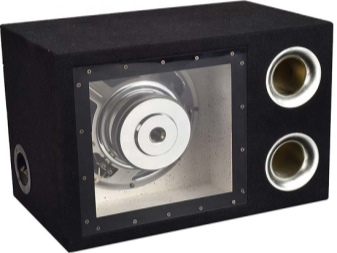

Active
Subwoofers of this type have a built-in amplifier, with the help of which the incoming sound is processed. Such models can have a wired or wireless connection with other components of the speaker system, connect directly to it. These subwoofers are more expensive than passive ones. Monolithic acoustics are always more compact, but they lose some in sound quality due to the need to place all the components in the case at once.
Among the obvious advantages of active subwoofers is a significant reduction in the load on the home theater receiver. Bass reflex models of this type are designed for installation in a large space, where a significant volume of air masses is available for oscillation. In confined spaces, such as in the trunk of a car, they will resonate. The disadvantages include heating the air in the case, the absence of additional filters from interference.
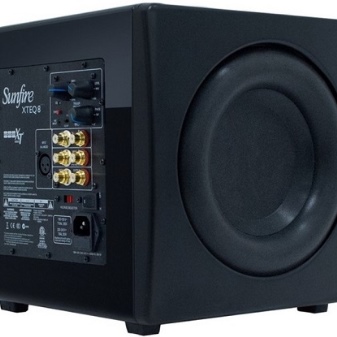
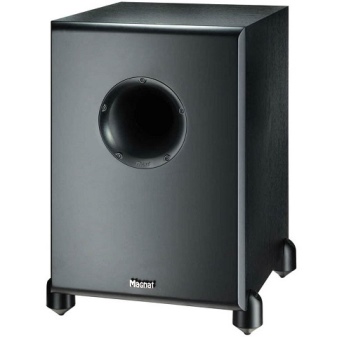
Passive
Such a subwoofer is equipped with one or more low-frequency heads and is connected to an amplifier via a cable. It is well suited to be included in a home theater system. In this case, it is the external amplifier that is connected to the receiver. Such devices have no restrictions on the shape and size of the case; they are often made in an unusual configuration.
Sometimes passive subwoofers are connected through a crossover. This combination makes it possible to deepen the sound of the bass. In addition, the range of supported frequencies is noticeably increased. Of the disadvantages of passive models, we can note the deterioration of sound at high volume - they are used mainly at an average level.
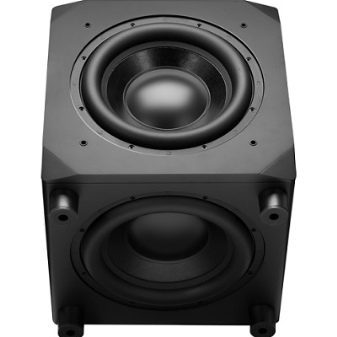
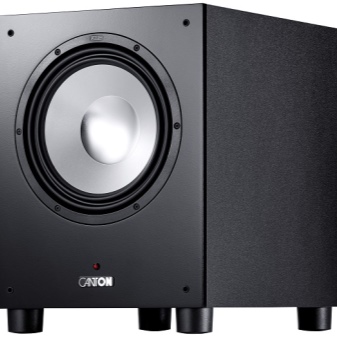
Rating of the best models
It is customary to choose subwoofers according to the sound quality, compliance with the technical characteristics of the tasks set for the device. Let's take a closer look at the top of the best and most relevant models.
- JBL LSR310S. The best option in terms of price and quality ratio. The cabinet is made of wood panels and has 2 balanced inputs on the rear panel, allowing you to connect equipment for live and studio use. The subwoofer has a power of 200 W and easily covers an area of up to 45 m².
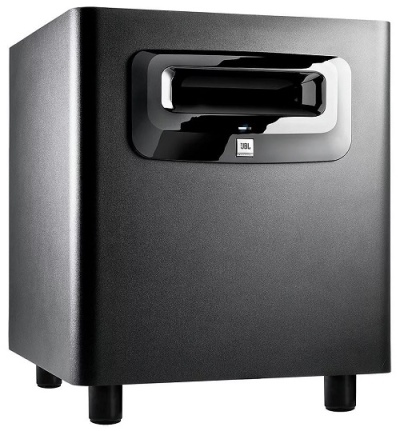
- Polk Audio PSW111. This subwoofer is designed in the USA, assembled in China. The model is designed for rooms with an area of up to 30 m², itself takes up no more than 1 m². The equipment is equipped with a built-in amplifier, composite cone and bass driver. The body is made of MDF, there are ribs and dampers inside to dampen the resonances that arise. The subwoofer weighs 9 kg.
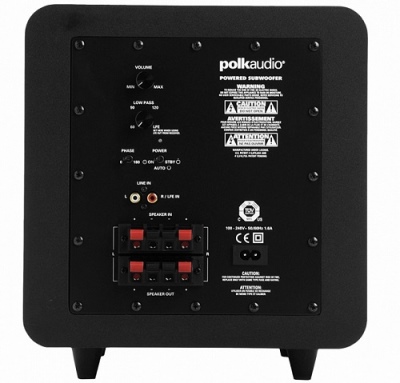
- Onkyo SKW-770. Budget bass reflex model from a well-known Japanese manufacturer. It is distinguished by the presence of the Standby function, operating frequency range from 25 to 200 Hz, compact size, convenient for table and floor placement. Power of 120 W is sufficient for rooms with an area of no more than 30 m².
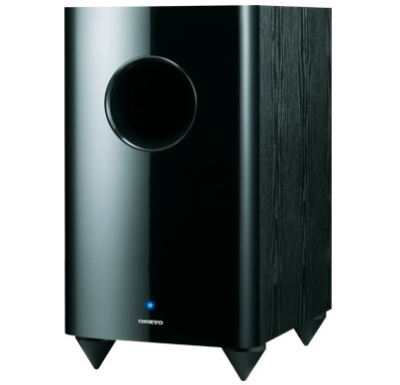
- Pioneer S-51W. An active subwoofer from a Japanese brand known for its car acoustics. In the home version, there is an option for rooms with an average area - up to 20-25 m².The model has a wide range of operating frequencies - from 26 to 900 Hz, the driver with a diagonal of 20 cm works in conjunction with a 150 W amplifier.
The subwoofer has an elegant design that fits well into almost any interior.

- Yamaha YST-FSW100. A budget closed-type subwoofer for rooms up to 20 m². The best choice for home use - the equipment is assembled in Indonesia, has a power of 130 watts. The sound is monopolar, directional; you can adjust the sensitivity and volume not only by software, but also by changing the position of the device in space.
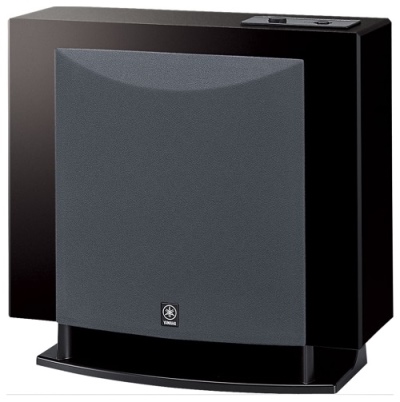
- MJ Acoustics Reference 100 MKII. The most technologically advanced subwoofer produced in England. It has a very interesting feature set. The model belongs to closed-type subwoofers, the bass sounds clear and without extraneous distortion. Power of 120 W is enough for a room of 30 m², the equipment is equipped with an additional pair (loudspeaker / amplifier in a common housing). This subwoofer even reproduces frequencies at the infrasound level - up to 13 Hz, there is a crossover frequency adjustment and overload protection. The control is carried out from the proprietary remote control.
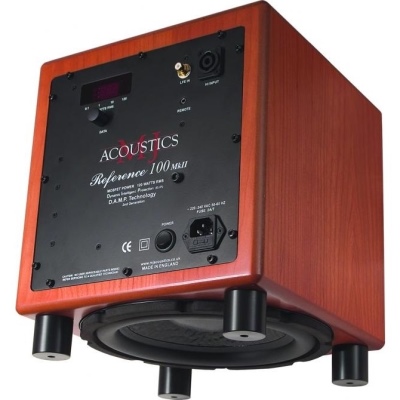
How to choose?
When choosing a subwoofer home, you should pay attention to a number of points that determine the convenience of its operation. What matters is both the subjective feeling of its sound, for example, the assessment of juiciness, brightness, loudness, and an objective consideration of the technical characteristics. Several of the most significant parameters are worth noting.
- Operating frequency range. For private use, subwoofer models with a range from 20 to 80 Hz (deep and medium) are suitable. Higher performance in a home theater system or full-fledged acoustics usually have satellites - speakers. Accordingly, the range of capabilities of the subwoofer above 80 Hz will not be fully disclosed.
- Sensitivity. It is determined by SPL - sound pressure. The higher they are, the less amplifier power will be required to ensure good loudness.
- Dimensions and weight. For a small room, it is better to choose more compact bass reflex models. Due to the design features, they are placed in the most compact cases. All other subwoofers are sized and weighted in proportion to their wattage. The largest and heaviest models are designed for concert halls.
- Sound quality. It directly depends on the type of acoustic design of the product. Powerful closed-design subwoofer for the lowest acoustic distortion. It is ideal for listening to music, but it is the largest in size and bulky in execution. An alternative to it can be a model from Yamaha. This brand has subwoofers with passive radiators and acoustic labyrinths to reduce the size of the cabinet without sacrificing sound quality.
- The presence of an amplifier. For home use, a subwoofer with a built-in module will be the best choice. A set of a low-frequency device with an amplifier in the case will allow you to directly connect to a home theater system, a computer. The amplification power is also important - 40-50 W is enough to ensure the normal operation of the subwoofer with a sensitivity of about 85 dB.
- Dimensions and performance of speakers. There is a fairly clear division here. For example, a model with a small 8-inch paper woofer is considered a good addition to a desktop audio system. For home theater applications, diffusers should be 2-4 inches larger in diameter and made of carbon or metal.
These parameters can be called basic. It should be noted that for home acoustics, design and overall suitability of the sound system used are also important. It is optimal if the home theater and subwoofer are produced by the same brand.
Choosing a device from another manufacturer will require a more complex and accurate accounting of all parameters.
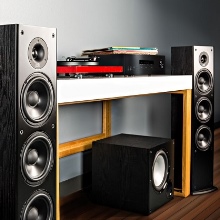
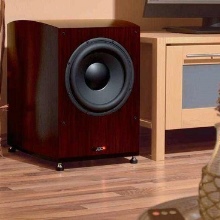
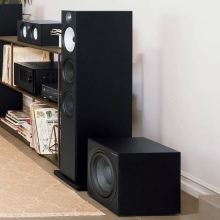
Connection and configuration
Installing a subwoofer requires a serious approach, because the correct choice of place for the device cabinet depends on how well it will cope with its tasks. It is worth considering that in a normal room, regardless of the area, the sound is reflected from the walls, the low frequencies lose their depth. If you want to get the most juicy bass, you should take care of thorough preparation of the room, with the isolation of surfaces with sound-scattering materials. The choice of location is usually done empirically. The subwoofer is turned on, a test recording is started, and then it is rearranged while listening to the same fragment. Where the bass will sound the most bright and loud, you need to install the technique on a permanent basis.
The need to adjust the subwoofer after connecting to the crossover arises in cases where you need to change the cutoff frequency - the level at which the sound from the speakers will be transferred to it.
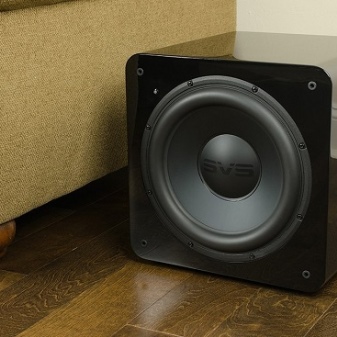
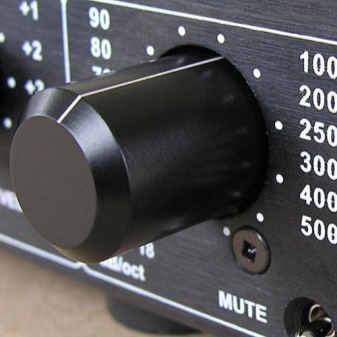
If the standard parameters are not suitable, you will have to adjust them manually. The average tuning level is considered to be 80 Hz. With an increase in this indicator, the frequency range of the subwoofer will also increase.
You can connect the device to a home theater receiver or speaker system directly using an RCA cable. This method works for active subwoofers already equipped with a built-in amplifier. It is enough to wire all the components together and the system will work. If you need to connect a passive subwoofer, some systems already have a bass amplifier for this. When it is not there, you will have to use the stereo amplifier as a common circuit element, connecting it to the stereo pair and the input of the device.

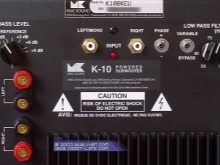
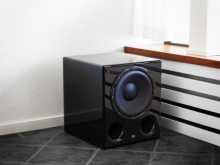
For information on how to choose a budget subwoofer with a box, see the next video.









The comment was sent successfully.